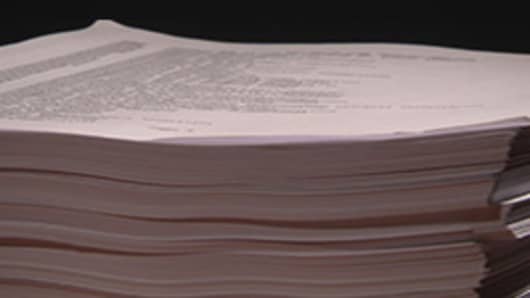American health care in the 21st century is a numbers game — literally. The Centers for Medicare and Medicaid Services provides coverage for 100 million Americans and processes some 4.5 million claims a day to the tune of $800 billion annually.
But that’s not all.
“Medicare is a big program. Medicaid is a big program. We have 800,000 physicians; we have 1.5 million providers and suppliers. We have these millions and millions of claims every day,” said Dr. Peter Budetti, deputy administrator for program integrity at the centers.
And the numbers don’t end there.
Health-care providers currently use a list of more than 18,000 diagnosis codes, known as International Classification of Diseases, 9th Edition (ICD-9), to bill Medicare and Medicaid. Next year, the number of codes will expand to more than 140,000, with the goal that more specific diagnoses will lead to better tracking of health-care trends and cut down on fraud, which costs taxpayers at least $80 billion a year.
The sheer size of ICD-9 makes it a minefield for some providers and suppliers submitting claims for payment and a potential goldmine for others.
Fighting fraud is more than half the battle. The U.S. fee-for-service model, where providers are paid by procedure, has lent itself to a type of fraud known as “upcoding,” officials say. Providers use the higher-fee codes to charge the government for lower-fee procedures or, in some cases, services not rendered at all.
The complicated coding system has also given rise to a number of businesses that offer to teach providers how to navigate it.
Dr. Adam Alpers is an osteopath in Ocala, Fla., and one of many offering an online course on how to use certain billing codes to generate more revenue.
In the course, “Medical Coding Cash Secrets,” Alpers details several ways health practitioners can use alternative codes to bill Medicare for claims that pay higher fees.
CNBC purchased Alpers’ program to learn more. Here’s an excerpt of one transcript:
“The average Medicare reimbursement for code 94620 is $72.48. That’s the Pulmonary Stress Test (Simple). The average Medicare reimbursement for code 94761, which is walking around with a pulse oximetry to test for pulse and oxygen, is only $7.12. Today we’re going to teach you how to perform just a little bit more in your office and capture 10 times as much money doing just a little bit extra.”
Alpers goes on to explain the detailed requirements of the pulmonary stress test, emphasizing a physician should document the test extensively, but also notes it is not required for the physician be present during every test.
Alpers says his teachings are ethical and proper. Administration officials admit a fine line exists between honest mistakes and errors due to a complicated coding system and outright fraud.
“To the extent that people are being taught to go beyond what's appropriate — not just to get appropriate amount of money for what they've done and to avoid losing money, but how to go about couching things in a way that is not honest — that goes beyond what they actually deserve to get paid. That does concern us,” Budetti said.
Alpers declined CNBC’s requests for an interview, but told us in an email, “I have tried to teach proper guidelines to the complicated process of documenting an office visit according to proper protocols which are in writing.”
Advances in technology, a reorganization of private contractors tasked with analyzing claims data and additional funding from President Barack Obama’s Affordable Care Act have helped the fight against health-care fraud.
As a result, the government’s focus has shifted from the traditional “pay and chase” model to preventing fraudulent payments before they’re paid. In the past, officials say, it was common for taxpayer money to be paid to fraudulent providers for months, even years, before law enforcement had enough evidence to arrest an alleged criminal.
Safeguard Services LLC, a subsidiary of Hewlett Packard, is one of several Zone Program Integrity Contractors, tasked with a $72 million government contract to identify and investigate health-care fraud in one of seven zones across the country.
Zone 7, which includes Florida, Puerto Rico and the U.S. Virgin Islands, makes up about 8 percent of the total volume of Medicare and Medicaid claims — and it’s rampant with fraud.
“We have a large number of very smart fraudulent schemers. And as quickly as you stop one scheme, they're thinking of another one. So they're not shy to jump from one line of Medicare to the other,” said Raul Martinez, Zone 7 fee-for-service task order manager for Safeguard Services.
With a new $77 million computer system for data analysis in place, officials from the Centers for Medicare and Medicaid Services (CMS), the Department of Health and Human Services and the Office of the Inspector General agree the process of identifying bogus claims and preventing payments for fraudulent activity from going out in the first place is picking up speed.
“In the past we relied on CMS and their contractors [be]cause we did not have direct access to this data, and they would sometimes take as much as 90 days to provide a response if we requested information," said Gary Cantrell, assistant inspector general for investigations at HHS. "So that’s basically 90 days where this case is sitting on the sidelines while we wait for information. Now we can look this information up directly, and move on much more quickly.”
In the fight to protect taxpayer dollars from going to crooks, time is a critical component.
“The fraudsters, are working much more quickly to basically take advantage of this program," Cantrell said. "We see companies come into business, within three months, they go dormant. So basically, they set up a sham operation, bill Medicare for as much as they can as quickly as they can, and then move on to avoid detection.”



